Employee turnover is an expensive problem plaguing modern workplaces – can a cure be found?
There’s a growing tension between employees and employers. At first glance, both parties have the common goals of creating fulfilling workplaces, fit for purpose, in an increasingly stressful and demanding world. But something just isn’t working. Employees report feeling dissatisfied with their work environments as employers keep expanding benefit packages and adapting offices to look more like playgrounds than typical workplaces.
All this is resulting in high rates of employee turnover that companies are struggling to tackle.
Employee turnover affects employees and employers in different but equally negative ways, ultimately decreasing productivity and work satisfaction from the bottom up and top down too. Here at Resource Guru, we believe that employee turnover is an issue that can only be tackled if it is first understood. We investigated the true cost of employee turnover and the causes behind it.
In this article 📖
What is Employee Turnover exactly and why does it matter?
Employee turnover refers to the percentage or number of workers that leave an organization and need to be replaced by new employees. Companies with high rates of turnover suffer from decreased productivity, low work satisfaction, and higher reports of burnout. A workforce that experiences high rates of turnover is always in a state of imbalance that negatively affects the bottom line. Replacing employees is expensive, but the true cost reaches beyond financials.
Workplaces which are destabilized through turnover reflect poorly on all parties – the overall impression of a company falls in the eyes of potential recruits, while employees who remain in the business are left to pick up additional work or deal with teams changing around them.
Turnover rates vary from industry to industry, and by company size. We conducted a survey of 500 executives and 500 managers to find out more about the differences and unearthed some concerning results.
Survey findings
In 2018, companies with less than 50 employees lost 23% of their workforce to turnover and though the rate decreased for larger companies, it still indicates a serious problem for employers. The survey also looked at the difference in attitudes between senior and managerial staff (i.e. the decision makers), versus junior and non-management staff (‘executives’ in the survey); it revealed that those in junior roles have a harsher perception of their company’s turnover rates, with 58% reporting high rates of employee turnover compared to 51% of senior staff members. This difference in perception can start to explain why it’s difficult to reduce turnover rates from the top down when it demonstrably affects those at the bottom of the hierarchy more.
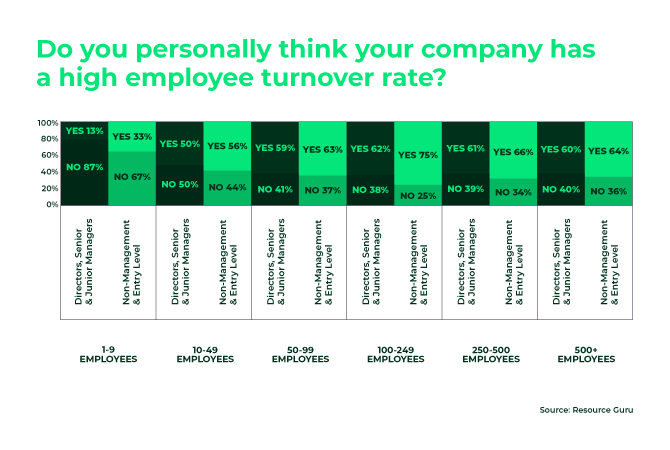
Cost of staff replacement is at the heart of the conversation about turnover. In the UK, there is an upward trend when it comes to the perceived cost of replacing staff, starting at £2,697 for a company with 1—49 employees and almost doubling to reach £4,769 for a company with more than 500 employees. This, however, is just an average that doesn’t split the number by industry. When broken down, this number can grow, especially when it comes to legal and STEM-based industries, where the right candidate must have a mix of formal and specific training.
Additionally, we wanted to look at the ‘true’ cost versus what employees think it costs – and the difference is stark. Let’s first consider all the elements involved in replacing an employee – they look a little something like this:
- Creating a job specification
- Briefing recruitment consultants
- Candidate screening
- Initial and telephone interviews
- Interviewing
- Onboarding
- Handover
- Training
In business, time always equals money and when all the above elements are accounted for in terms of cost, the final number is significantly larger than the reported perceived amounts seen on the first graph. Figures available calculate that the average replacement fee for a departing employee stands at just over £30k – this is 6 times higher than the perceived cost. The figure is made up of two parts. One is the cost of logistics, such as advertising and agency fees, standing at £5k and the other is wages during the time when a new employee is yet to reach peak productivity, amounting to just over £25k.
The true cost understandably varies by industry too. Legal workers were found to be the costliest to replace at £40k as it takes an average of 32 weeks (8 months) for new hires to reach peak productivity. The media and advertising sectors, in comparison, have a shorter window to peak productivity – 20 weeks (5 months), so the cost of staff replacement is lower at £26k. Replacing IT workers will cost on average £32k as peak performance won’t be reached until 28 weeks (7 months) into employment.
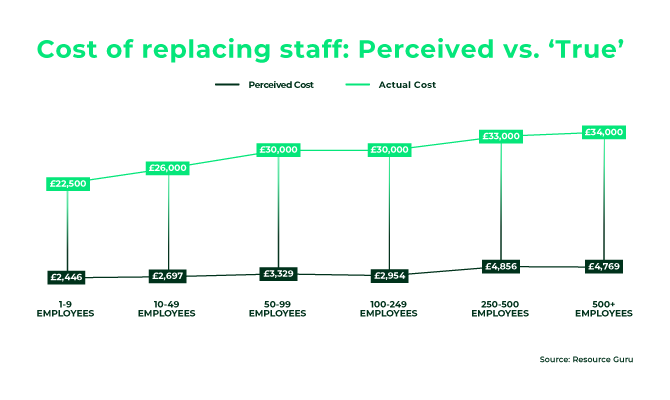
Associated costs and peak productivity are the heart of the true turnover cost that so many businesses don’t consider. The shocking numbers highlight why businesses must do everything possible to minimize turnover.
Businesses need to have an agile and proactive approach when it comes to tackling rates of turnover with a view of solving issues effectively as they arise, if not before – not solving problems after they’ve caused irreparable damage. In order to reduce high turnover, we first need to understand what can cause it.
Factors Contributing to High Turnover Rates
The survey data we gathered, together with secondary research, found many causes behind high rates of turnover. Employers and employees need to get a clearer understanding of the factors negatively shaping workplaces and affecting retention efforts if any are present at all. Below is a closer look at the individual factors affecting turnover in the workplace today.
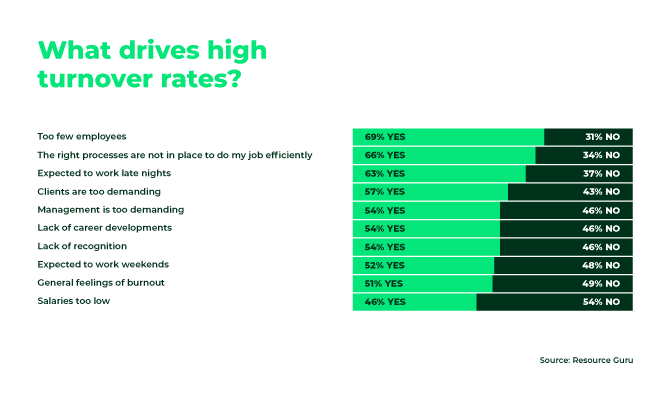
Work Dissatisfaction
Let’s consider the following: high rates of turnover lead to even higher rates of turnover. To breakdown this head-scratcher we need to consider that 69% of companies with high turnover rates report suffering from ‘too few employees.’ An understaffed workforce is always going to feel the strain of the recruitment cycle.
Turnover and recruitment disturb processes and employee productivity, meaning the extra work created by a vacant position must be completed by other staff until a suitable replacement is found.
Employees strive to work in an efficient manner but chronic understaffing and a conveyor belt of incoming and departing recruits thwarts these efforts. This prevents a company’s ability to establish the processes that 66% of respondents stated were necessary for efficient working.
Company Culture
Company culture has changed a lot in recent years – often pioneered by tech startups and industry disruptors, now many ‘traditional’ companies are trying to follow suit. This has resulted in a host of perks like leisure facilities, free food, and frequent team days out (organized fun).
What many companies have failed to consider is whether these efforts match the needs and wants of their employees and if it benefits everyone equally. The blurring of leisure and work often leads to diminished boundaries between the personal and professional. It can create an obligation to surrender what little home time there is for fun, yet mandatory, team activities instead. Work/life balance often remains a distant myth at a time when so many employees report craving it most.
Lack of Meaningful Development
For employees in industries like the arts, low salaries are an unfortunate but expected reality with only 14% of survey respondents stating they would leave over pay. For 21% it’s a lack of career development that’s the driving factor behind a job change. Interestingly, competitively paid industries like finance and law also single out development as a factor contributing to turnover, with 19% and 22% respectively giving this as the reason for leaving.
Employees want to feel that their work is ultimately getting them closer to the next step in their career, be that a promotion or a pay rise. Supposed workplace stagnation by employees is particularly difficult to endure in deeply hierarchical industries like finance and law. Job recognition and salary increases in those sectors are closely tied to moving up the corporate ladder. The arts and culture sector are, comparatively, more structurally relaxed but seniority is inevitably tied to more job satisfaction and higher pay, which is what most employees will be chasing.
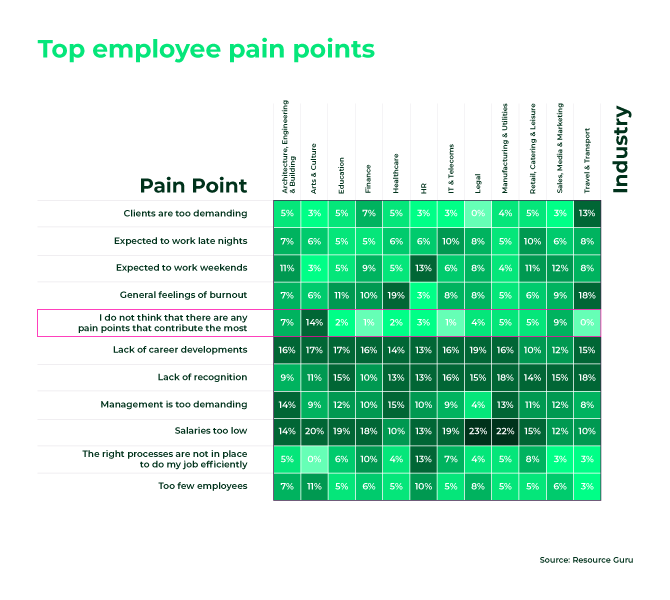
Every employee, no matter the industry, wants to feel that their job is leading to bigger and better things which can be obtained through hard work and dedication. Workplaces that fail to provide desired and meaningful development will suffer from higher turnover.
Burnout
Burnout isn’t a new concept, but it is one affecting a lot of modern workers today. Separate from stress, burnout is characterized by physical and emotional exhaustion which leads to feelings of detachment, ineffectiveness, and lack of accomplishment. Stress is a short-term reaction to something like a big project or pressing deadline – burnout is an ongoing condition and state of mind.
Of the people surveyed, 19% reported burnout to be the most significant factor contributing to high rates of turnover. Workplaces are always pushing for higher results, sometimes without meaningful rewards to make it feel worthwhile on an individual level.
People are berated by the infinite resource mentality, encouraged to ‘hustle harder’ and to ‘sleep when they’re dead’. Combine this with student loans, a highly competitive rent market, rising property prices and increasingly longer commute times – it suddenly becomes very clear why employees feel like they can’t stop or take a break. In today’s working culture, Elon Musk’s 80 hour weeks are fetishized and celebrated, not rightfully criticized for its unhealthy excess.
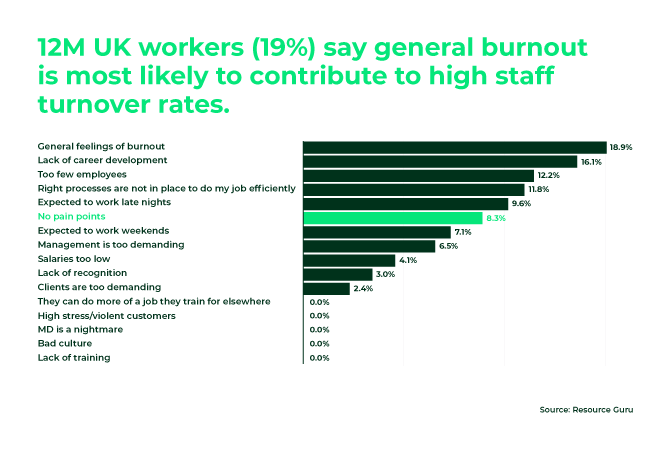
Salary
Salary is always going to be a significant factor behind rates of turnover. When we asked junior and non-managerial survey respondents for the number one reason they would leave their job tomorrow, 23% replied with salary.
It’s not new or surprising but it’s a truth that some companies don’t want to face. The cost of living, especially in metropolitan environments, is rising much faster than salaries, which have been stagnating in many markets over the last 10 years post the financial crash. Employees, specifically the millennial generation currently on track to never out-earn their parents, want to be offered competitive, healthy salaries above almost all other work perks.
Scarce Recognition
Employees want to feel part of a bigger mission and that their contribution makes a difference. Inefficiently managed workplaces often fail at providing the timely recognition needed to retain staff. It’s not about needless praise but an acknowledgement of positive contributions made by staff to the wider workplace objectives.
High-revenue rate companies suffer from this pain point more acutely as employees report feeling, predictably, like cogs in a machine. Employees in these companies often struggle to see their daily work in a meaningful light.
Workplaces need to address employees’ feelings of being undervalued to tackle disengagement and reduce rates of turnover. Employees striving to connect to their work should be seen in a positive light and should be nurtured and encouraged by management through recognition.


“Resource Guru simplifies the way we work and gives us a holistic view of what’s happening.”
Turnover Factors Summary
Turnover is a highly complex issue for modern workplaces to tackle. The factors above make it clear that it’s never only one thing contributing to staff leaving, with the reasons growing more complex when broken down by industry.
What emerges is an outline of modern employees who are striving to contribute meaningfully to their workplaces while looking for good remuneration, timely recognition, and an opportunity for development.
Companies like proposing inspirational mission statements, hoping to attract the best candidates, but without addressing the above factors, they’re unlikely to retain them for any meaningful amount of time.
Workplace Guide: How to Create a Fulfilling Workplace
Consolidating the factors that contribute to high rates of employee turnover may have painted a less than stellar picture of modern workplaces, but now is not the time to despair. Though complex, addressing these issues and rectifying the negative trends when it comes to staff retention isn’t an impossible goal.
Our research has highlighted changes that can be made to attract and retain the best talent. With that in mind, we at Resource Guru have created a straightforward workplace guide to reference when evaluating company issues as related to turnover.
Implement real work/life balance
It’s time to stop penalizing workers for wanting flexible working arrangements that make meaningful work/life balance possible. Instead of asking ‘why’ when it comes to offers of flexible working, workplaces should trial a ‘why not?’ approach.
So many companies are looking to attract employees classed as independent self-starters but fall short of offering them the trust and flexibility of actually being independent. Presenteeism is proving hard to shake and productivity is still partially measured by office attendance, not work output. The sooner workplaces embrace a shift from bodies in the office to work product and quality, the sooner employees will feel like they’re supported by their employers.
Tech is the ideal companion to make this happen, and fast. Micromanagement must be left in the past but managers, understandably, need a way of tracking productivity and progress. The utilization of resource management software, like Resource Guru, provides a solution that offers full visibility of team projects yet still affords employees autonomy over their own productivity. Implementing symbiotic solutions is the way to build futureproof, collaborative, and progressive workplaces.
Offer professional development
Workplaces need to evaluate the quality of development and training on offer. Research has found that many employees would prefer to participate in relevant training programmes and development schemes over other benefits, which contrasts with how many employers, especially in the startup sphere, think about benefit packages.
Creating highly individual development plans can be just one of the ways for workplaces to show employees that their development isn’t an afterthought, but an active strategy on the part of the employer to add value to their employees’ skills.
It’s vital to identify which skills employees want to develop further, and then implement frequent and measurable training periods through paid courses and mentorship schemes. Employees want tangible action the same way employers do.
Make professional development part of your hiring promises, being sure to keep them once employees are on board to minimize rates of turnover.
Review the salary package
This point could be made subtly but it’s better to be frank: salary matters. It always has and it always will. Employees are looking for competitive salaries, alongside salary progression plans and salary reviews where applicable.
If employees can get a better salary at a different company, there’s a good chance they’re going to take it. Lack of transparency over company pay and continued haziness and hesitation over raises all contribute to employees keeping their options open and even conducting active searches for other opportunities. It’s been reported that employees who stay in a job longer than two years will earn 50% less than their colleagues who swap jobs.
Often, the cost of replacing an employee is higher than the raise that would keep them. Regular raises can contribute to lower business costs when calculated over the long-term.
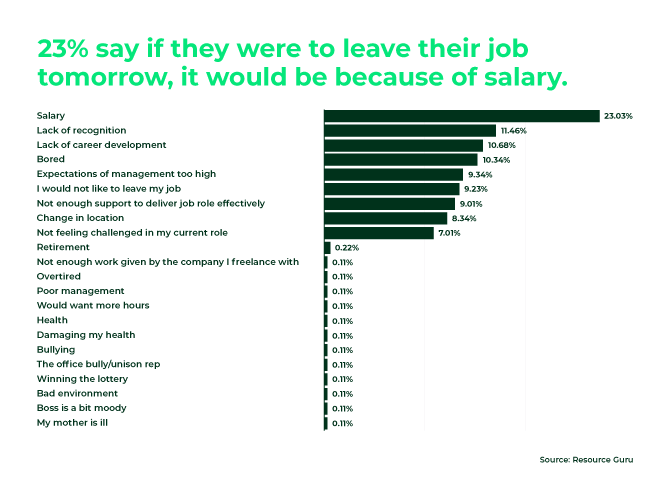
Create opportunities for promotion
Employees want a connection to the business’s macro objectives and to believe that the effort they put in can be transformed into progress and promotions. When employees feel detached, or too far from the promotional track, they start to feel unfulfilled in their workplace. This leads to resentment, dips in productivity, and the search for a new job begins.
The solution lies in reviewing what kind of future the company can offer its employees while communicating, with a high degree of transparency, those possibilities and the path to achieve them.
Employees aren’t looking for instant gratification, instead it’s about seeing themselves as part of a company’s future. It’s about building a vision of individual return on investment, where dedication and high standards of productivity will secure future career rewards.
In an uncertain world, employees are searching for the security and stability that career development brings through increased responsibility. This translates to value, seniority, and higher pay – all the elements employees frequently report they’re searching for. That’s why employers should emphasize career development opportunities at the hiring stage and implement frequent career path reviews for existing company employees.
Summary
Companies need to understand that they’re operating in a highly competitive environment when it comes to recruitment and retention of highly skilled workers. Attaining and maintaining a steady workforce should be a priority for all companies with growth and success on their minds.
Employee turnover can only be minimized when it is fully understood through a closer look at the data and cultural factors that contribute to employee dissatisfaction. Only then can the insights gleaned be transformed into tangible changes that benefits employees and employers every day.





